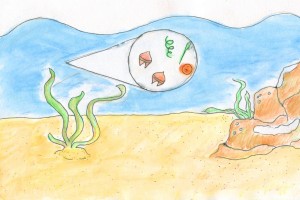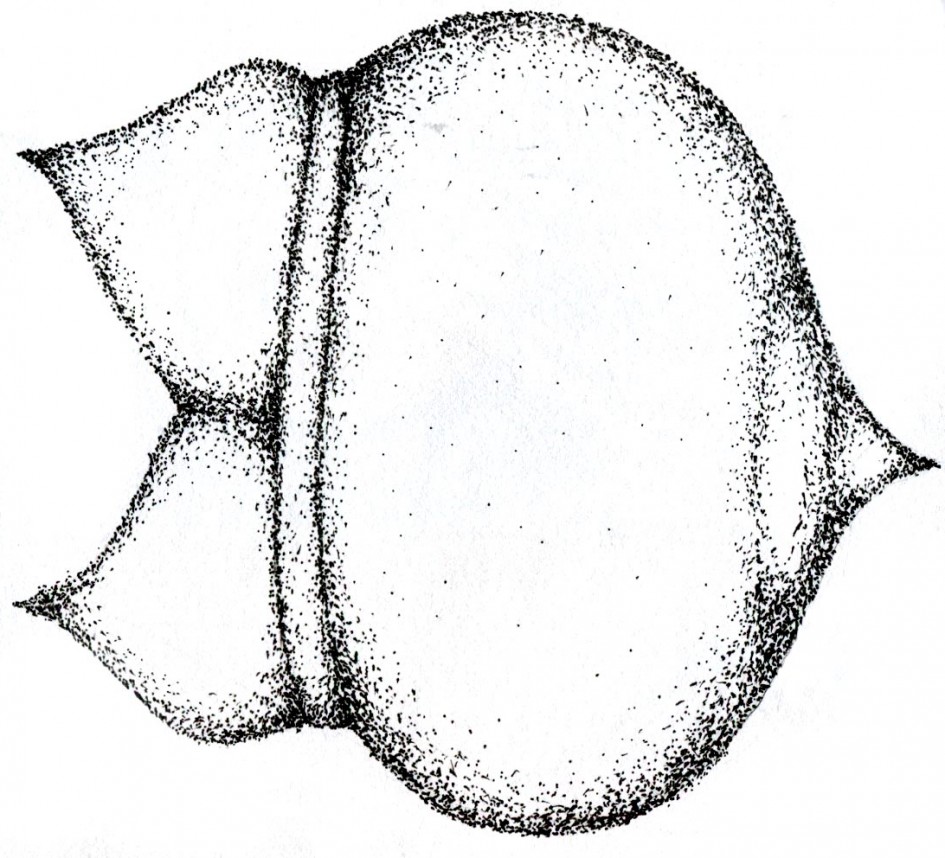Protoperidinium crassipes
By: Barent Vroman
Protoperidinium is a very diverse genus that is found all over the world. Even though there’s a very broad field of organisms, it was very difficult to find abundant information on these organism, so to help narrow down and obtain more precise inform I chose to do a specific species on these organisms. The species of protoperidinium I chose to base the information I found on these organisms are the Protoperidinium crassipes.

Radius: 22 μ Height: 36 μ
Protoperidinium crassipes are marine dinoflagellate that appear as a teardrop shaped with an apical horn on the top with two cones on the lateral side. They have a radius of 20 to 25 μm and a height from 32 to 45 μm (Helinski 2006). These P. crassipes are found in many waters that range from the North Atlantic oceans, the North West Atlantic, The Gulf of Mexico and etc. These proptoperinidiums can be found at max depths of 470 meters all the way up to the upper layers of bodies of water.(Guiry 2013) From observing protoperidinium they tend to move with their two cone shape legs and gyrate them to move around nutrient they want to digest shown in the animation. These organisms have a special feeding mechanism where they envelop their prey within a pseudo pod known as the pallium allowing it to consume prey that is even the same size as itself(Gribble 2007). The digestion occurs outside of the body acting as stomach and consuming it as a whole.
The Protoperidinium crassipes are known to have a toxic effect on their habitat around them because of the certain nutrients they absorb. These phytoplankton were until recently believed to have been producers of azaspiracid which can cause ADP neuro-toxic effects on humans but recent discoveries have shown that they are more of a transporter for this toxin. They transfer this toxin through them due to their consumption of azadinium becoming a conduit to these harmful toxins to the other organisms around them.(Guiry 2013) Since these dinoflagellates are huge basis of the beginning of the food chain network these toxins can affect a whole ecosystem around them.

P. crassipes in their environment.
Since these dinoflagellates absorb these toxic nutrients from their environment it has major impacts on the ecosystem in a negative way. They have been linked to because of their incorporation azadinium which produces the toxin AZP commonly known as shellfish poisoning(Gribel 2007). Due to their production of AZP they start acting as a transport of these toxins when they take place in the natural food cycle because they are commonly consumed from shellfish becoming potent with AZP carrying these toxin just as their prey before them. The reason why this is such a big issue is because in areas where local fisheries and harvest harbors are located can be lead to close down if touched with the toxins and can lead to a huge economic impacts stopping the inflow of money,jobs, and impact public health.(Gribble 2007) Aquaculture is a huge part of society allowing like said earlier jobs, economic growth, and a food source. So why aren’t these critically important phytoplankton studied more if they have such a huge impact on aquaculture and our economy? It is because our society has a bad habit where if don’t see it with our own eyes we tend to forget that there is life outside of our realms of vision until it starts to effect you.

P. crassipes and their economic potential.
We should pay special attention to these organisms because even though they are so small and tiny they can have such a big impact on our environment. They are a key part of the microbial food chain and have a major impact on our economies aquaculture. Investing more time in studying Protoperidinium could give us huge understanding on the toxins in our environment while allowing for our economy to prosper and maintaining public health. We as a society tend to forget that what we can’t see can still have a huge impact on us, so we tend to study the big and magnificent and devote time and money on research on things that are easily seen and noticeable. Art is a great medium for us to express and show the phytoplankton to the world, to show them off and let people know how important these small organisms can be. Little things tend to be the start of something huge, and in this situation the P. crassipes is a perfect example.
Sources
Kristin E. Gribble, Glenn Nolan, Donald M. Anderson . Jpr. Advance Access Published September 20, 2007. “Biodiversity, Biogeography, and Potential Trophic Impact of Protoperidinium Spp. (Dinophyceae) off the Southwestern Coast of Ireland.”Biodiversity, Biogeography, and Potential Trophic Impact of Protoperidinium Spp. (n.d.): n. pag. Web..
Guiry, Michael D. “WoRMS – World Register of Marine Species – Protoperidinium crassipes (Kofoid) Balech, 1974.” WoRMS – World Register of Marine Species – Protoperidinium crassipes (Kofoid) Balech, 1974. N.p., 15 July 2013. Web. 18 May 2016.
Olenina, I., Hajdu, S., Edler, L., Andersson, A., Wasmund, N., Busch, S., Göbel, J., Gromisz, S., Huseby, S., Huttunen, M., Jaanus, A., Kokkonen, P., Ledaine, I. and Niemkiewicz, E. Biovolumes and Size-classes of Phytoplankton in the Baltic Sea. Helsinki: Helsinki Commission – Baltic Marine Environment Protection Commission, 2006. Web.

